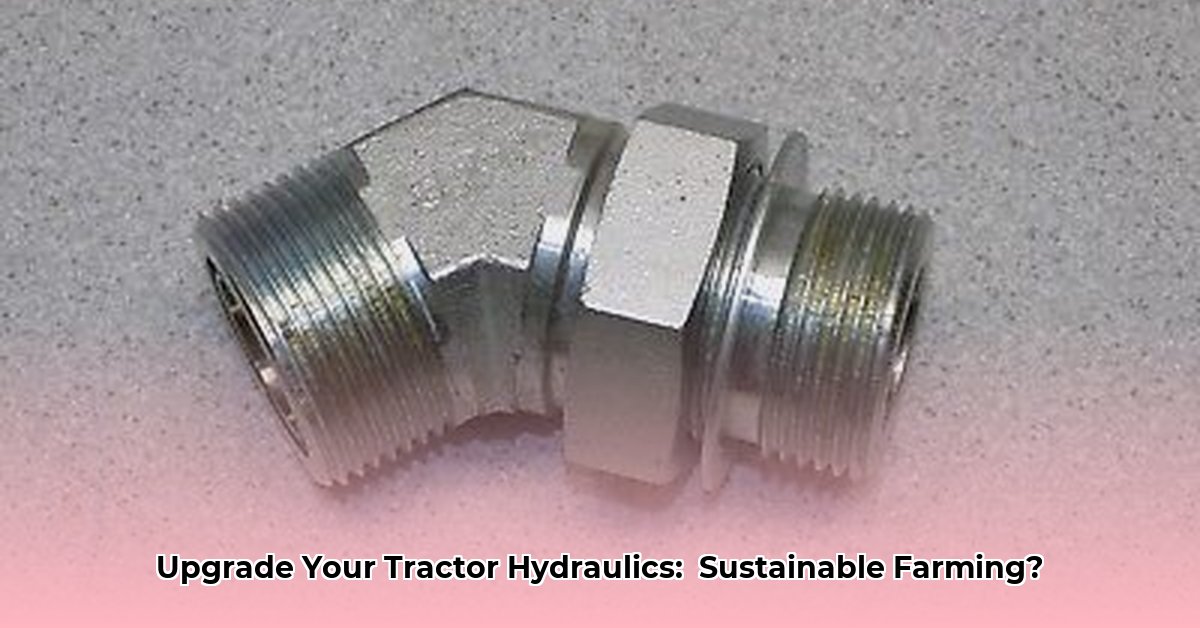
Maintaining your tractor's hydraulic system is crucial for efficient and sustainable farming. Often overlooked, hydraulic fittings play a vital role in ensuring the smooth and reliable operation of your equipment. This guide provides a comprehensive overview of selecting, maintaining, and replacing these essential components, enabling you to optimize your farm's efficiency and minimize environmental impact. For more detailed information, check out this helpful guide on tractor hydraulic fittings.
Understanding Your Tractor's Hydraulic System
Your tractor's hydraulics are its circulatory system, delivering pressurized fluid to power various functions. Hydraulic fittings act as connectors, ensuring fluid flows efficiently. Even a small leak can cause significant problems, from reduced power to complete system failure. Proper maintenance prevents costly downtime and boosts productivity. A well-maintained system directly impacts your bottom line and reduces your environmental footprint. Did you know that a single, undetected leak can waste hundreds of gallons of hydraulic fluid annually?
Types of Hydraulic Fittings
Several types of hydraulic fittings exist, each designed for specific applications and pressure ratings. Selecting the right fitting is critical for system efficiency and safety.
Common Fitting Types:
JIC (Joint Industry Council) Fittings: Robust and suitable for high-pressure applications (think 10,000 psi and above). They are commonly found in modern tractors.
SAE (Society of Automotive Engineers) Fittings: Versatile and cost-effective, often used in lower-pressure systems (typically up to 5,000 psi).
BSP (British Standard Pipe) Fittings: More common in older or imported equipment. Identifying the correct thread type (e.g., BSPP, BSPT) is essential for compatibility.
ORFS (O-ring Face Seal) Fittings: Known for their superior leak resistance due to the O-ring seal designed to prevent leaks.
Material Considerations:
The material of the fitting also significantly impacts its durability and environmental impact.
Stainless Steel: Highly resistant to corrosion and rust. Offers excellent longevity, especially in harsh environments. It is also readily recyclable.
Brass: Offers good corrosion resistance. However, it may not be as durable as stainless steel in extreme conditions. Recyclable, but less environmentally friendly than stainless steel in some contexts.
Steel: A cost-effective option but susceptible to corrosion. Proper coatings or finishes can extend its lifespan and minimize rusting.
Selecting the Right Fittings: A Step-by-Step Guide
Choosing the correct hydraulic fitting involves considering several key factors:
Pressure Rating: Always ensure the fitting's maximum pressure rating significantly exceeds your system's operating pressure.
Flow Rate: The fitting's flow capacity should match or exceed your system's requirements to prevent restrictions.
Operating Environment: Choose corrosion-resistant materials (like stainless steel) for harsh environments.
Thread Type: Double-check the thread type (JIC, SAE, BSP, etc.) to ensure compatibility with your existing system. A mismatch will lead to leaks.
Consult your Tractor Manual: Your tractor's manual contains precise specifications and recommendations for hydraulic fittings. Always consult it before purchasing replacements.
Preventative Maintenance: A Proactive Approach
Regular maintenance significantly reduces the chance of costly repairs. Adopting a preventative maintenance schedule is essential for long-term system reliability.
Monthly Visual Inspection: Check all fittings for leaks, cracks, corrosion, or loose connections.
Tightness Check (Quarterly): Gently tighten any loose fittings using an appropriate wrench. Avoid over-tightening, which can damage the fitting.
Cleaning (Semi-Annually): Use a brush and compressed air to remove dirt and debris to prevent premature wear.
Prompt Replacement: Replace any damaged or leaking fittings promptly. Don't wait until a small leak becomes a major problem. Replacing a leaking fitting today will prevent having to repair other parts of the hydraulic system later.
Troubleshooting and Repair: Addressing Common Issues
Hydraulic leaks are the most prevalent issue.
Locate the Leak: Pinpoint the source precisely.
Assess Severity: Small leaks from loose fittings often require tightening. Major leaks necessitate replacement.
Safety First: Disconnect power and relieve pressure before any repair.
Replacement: Follow manufacturer instructions for removal and installation of new fittings. Use the correct torque wrench to guarantee a secure, leak-free connection. Ensure proper alignment to avoid damage to the connection during tightening. A simple leak can become a significant problem very quickly.
Responsible Disposal and Environmental Considerations
Dispose of old fittings responsibly. Recycle metal fittings whenever possible. Opt for fittings made from recyclable materials. Sustainable choices minimize your environmental footprint and contribute to responsible farming practices.
Conclusion: Sustainable Farming Through Hydraulic Maintenance
Proper hydraulic fitting maintenance isn't merely routine; it's a cornerstone of sustainable farming. It increases efficiency, reduces costly repairs, extends equipment lifespan, and minimizes environmental impact. By prioritizing preventative maintenance, regular inspections, and prompt repairs, you ensure your tractor's hydraulic system operates smoothly, maximizing your operational efficiency and contributing to a more sustainable agricultural future. Remember, small details make a big difference in the long run.